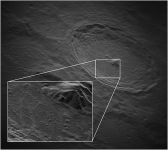Nuclear thermal propulsion systems would transfer the heat generated by a nuclear reactor to a liquid propellant such as hydrogen, which would then transition to the gas phase, expand and be funneled through a nozzle, creating thrust.
Not to be confused with the nuclear pulse propulsion of NASA's Project Orion in the 1950s which proposed propelling a spacecraft by detonating a series of atomic bombs behind the vehicle!
Not to be confused with the nuclear pulse propulsion of NASA's Project Orion in the 1950s which proposed propelling a spacecraft by detonating a series of atomic bombs behind the vehicle!
Attachments
Member
Joined 2009
Paid Member
There's a new technique available to help map the surface of the moon - could be good for NASA's planning team.
https://www.dpreview.com/news/60658...rototype-captures-detailed-images-of-the-moon
Planetary defense radar prototype captures detailed images of the moon
https://www.dpreview.com/news/60658...rototype-captures-detailed-images-of-the-moon
Attachments
A 5 metre resolution of the Tycho crater? Not bad!

Might be able to spot the descent stage of an Apollo Lunar Module, which is approximately 4.3 m in diameter with a landing gear span of 9.07 m.
Might be able to spot the descent stage of an Apollo Lunar Module, which is approximately 4.3 m in diameter with a landing gear span of 9.07 m.
https://theconversation.com/if-a-sa...al-penalties-for-leaving-junk-in-orbit-160757
I'd say they should have plenty of materials to build a decently sized space station and a couple of spaceships.
Should be a priority to get some robots up there to start gathering this junk, grind it all up, sort it and make new stuff out of it without having to defy gravity yet again.
I forgot about this thread about Artemis or I would not have made that new thread about the Aerospike engine a short while ago, seems you have not discussed it here so... link:
https://www.diyaudio.com/community/...ed-rdre-aerospike-engine.395153/#post-7252341
Oceans, air and now space.... why can't we be a bit more gentle to our environment? We are a sad sort.
//
//
Very true.
At least the space junk should be viewed as a lucrative resource.
Much of it is valueable metals or alloys that should/could be used again, most of it will most likely just burn up if it hits the atmosphere, so why not put it to good use and save tons of fuel and mining waste at the same time?
It should be good money to sort that stuff out.
Edit:
https://orbitaldebris.jsc.nasa.gov/faq/
That is potentially a lot of fuel saved if it could be repurposed.
Edit2:
No concrete numbers regarding mass per particle size, almost seems as if they are being intentionally vague, but if we can assume it is:
4000 tons >10cm size @ 25 000 objects = average 160 kg per object
2500 tons 1-10cm size @ 500 000 objects = average 5 kg per object
2500 tons <1cm size @ 99 475 000 objects = average 2.5 grams per object
I expect these numbers are not correct, it is just a very rough "guesstimate" from my part of the general distribution of mass vs particle size.
At least the space junk should be viewed as a lucrative resource.
Much of it is valueable metals or alloys that should/could be used again, most of it will most likely just burn up if it hits the atmosphere, so why not put it to good use and save tons of fuel and mining waste at the same time?
It should be good money to sort that stuff out.
Edit:
2. What are examples of orbital debris?
Derelict spacecraft and upper stages of launch vehicles, carriers for multiple payloads, debris intentionally released during spacecraft separation from its launch vehicle or during mission operations, debris created as a result of spacecraft or upper stage explosions or collisions, solid rocket motor effluents, and tiny flecks of paint released by thermal stress or small particle impacts.
3. How much orbital debris is currently in Earth orbit?
More than 25,000 objects larger than 10 cm are known to exist. The estimated population of particles between 1 and 10 cm in diameter is approximately 500,000. The number of particles larger than 1 mm exceeds 100 million. As of January 2022, the amount of material orbiting the Earth exceeded 9,000 metric tons.
https://orbitaldebris.jsc.nasa.gov/faq/
That is potentially a lot of fuel saved if it could be repurposed.
Edit2:
No concrete numbers regarding mass per particle size, almost seems as if they are being intentionally vague, but if we can assume it is:
4000 tons >10cm size @ 25 000 objects = average 160 kg per object
2500 tons 1-10cm size @ 500 000 objects = average 5 kg per object
2500 tons <1cm size @ 99 475 000 objects = average 2.5 grams per object
I expect these numbers are not correct, it is just a very rough "guesstimate" from my part of the general distribution of mass vs particle size.
Last edited:
Was over the edit limit.
So start with the big stuff that is easy to find, some of the "upper stages", "carriers for multiple payloads" and "derelict spacecraft" are probably easier to repurpose without grinding it completely down, cut them up and re-use some plating etc. Try to get maybe all the stuff down to 5cm size and push the rest into orbit using designated sattelites targeting particles with short bursts.
So start with the big stuff that is easy to find, some of the "upper stages", "carriers for multiple payloads" and "derelict spacecraft" are probably easier to repurpose without grinding it completely down, cut them up and re-use some plating etc. Try to get maybe all the stuff down to 5cm size and push the rest into orbit using designated sattelites targeting particles with short bursts.
This was a problem when I worked on satellites in the early 90s. A space shuttle mission had the windscreen damaged by a 0.2mm fleck of paint!
Satellites are remarkably unrecyclable though. Solar panels become less efficient, electronics was old tech before they went up and the box is glued together honeycomb with a big tank of explosive in the middle. Tanks never completely empty. So de-orbiting is the best option we have right now.
Satellites are remarkably unrecyclable though. Solar panels become less efficient, electronics was old tech before they went up and the box is glued together honeycomb with a big tank of explosive in the middle. Tanks never completely empty. So de-orbiting is the best option we have right now.
So it is not at all feasible to, at the very least, gather up the big stuff in a big lump and let it sit there until it is possible to get equipment up there to deal with it?
As you say, there's fuel and whatnot in the tanks, I would imagine it should be possible to crack it open in a controlled manner somehow, remove most of it and incinerate what is left on the inner surface.
Solar panels become less efficient, yes, but the major parts are silisium and that should be possible to re-use, if you do not want to make the effort to melt them into new "rods" then it is possible to spin insulation from it.
I realize this may seem far fetched, but we can do so much using automated processes and robots these days, I really do not view these options as impossible.
Edit:
What it boils down to, at least for me, is:
Is it a problem? If yes, then:
Should we do something about it? If yes, then:
Do what we can at sensible cost to at the very least make it manageable.
I have a very hard time believing that it makes good economical sense to blatantly ignore issues like this forever.
1. "Oh, this is becoming a problem."
2. "What can we do about it."
1. "Weeeeell, the easiest solution is probably to find a way we can track and evade the issue until it becomes a problem for someone else?"
2. "Sold! I want you to get on this ASAP, if you handle this well we can talk about a promotion and a few other benefits."
As you say, there's fuel and whatnot in the tanks, I would imagine it should be possible to crack it open in a controlled manner somehow, remove most of it and incinerate what is left on the inner surface.
Solar panels become less efficient, yes, but the major parts are silisium and that should be possible to re-use, if you do not want to make the effort to melt them into new "rods" then it is possible to spin insulation from it.
I realize this may seem far fetched, but we can do so much using automated processes and robots these days, I really do not view these options as impossible.
Edit:
What it boils down to, at least for me, is:
Is it a problem? If yes, then:
Should we do something about it? If yes, then:
Do what we can at sensible cost to at the very least make it manageable.
I have a very hard time believing that it makes good economical sense to blatantly ignore issues like this forever.
1. "Oh, this is becoming a problem."
2. "What can we do about it."
1. "Weeeeell, the easiest solution is probably to find a way we can track and evade the issue until it becomes a problem for someone else?"
2. "Sold! I want you to get on this ASAP, if you handle this well we can talk about a promotion and a few other benefits."
Last edited:
oh agree we can't ignore it, but given the cost/kg to launch things its very very expensive until one in 10 launches gets hit by debris and manned space flight becomes too dangerous I doubt there will be really serious attempts to deal with the problem. De-orbiting second stage rockets is one of the biggest wins which is at least sometimes happening.
KaffiMann's image of space debris is computer generated and the dots are not to scale. In actual photographs of the Earth we don't actually see an orbital landfill circling our planet.
This is to do with perspective - the things that humans build are tiny compared to the vastness of our planet.
Satellites range in size from only 4" each side (CubeSats) to ones that can be over 100 ft long (communication satellites). However, even 100 ft is tiny when you consider that the Earth is 7,918 miles across.
Even the largest human-made object orbiting the Earth, the International Space Station (which measures 375 ft from end-to-end), isn’t large enough to register on the DSCOVR satellite’s camera, which took this picture of the Earth from a million miles away.

But granted, even though space junk is not visible in the above image, it is a highly visible problem to people involved in spaceflight.
This is to do with perspective - the things that humans build are tiny compared to the vastness of our planet.
Satellites range in size from only 4" each side (CubeSats) to ones that can be over 100 ft long (communication satellites). However, even 100 ft is tiny when you consider that the Earth is 7,918 miles across.
Even the largest human-made object orbiting the Earth, the International Space Station (which measures 375 ft from end-to-end), isn’t large enough to register on the DSCOVR satellite’s camera, which took this picture of the Earth from a million miles away.
But granted, even though space junk is not visible in the above image, it is a highly visible problem to people involved in spaceflight.
I think that part of the problem is that it is not perfectly visible, and with 100 000 000 objects of wildly varying mass and orbits travelling at many thousands of kilometres per second, I expect that sometimes some of these will hit each other, at these speeds it will not take much mass to change the trajectory of another object of larger mass. Predicting the movement of all these objects must be a constant problem.it is a highly visible problem to people involved in spaceflight.
Will you be able to tell if something small and pitch black is coming towards you at a speed of 15km/s in a dark room?
There is still a lot of space in-between these things hurtling around, but it is not a constant amount of space, and it is getting worse all the time.
travelling at many thousands of kilometres per second
The European Space Agency considers it as "catastrophic" if an object larger than 10 cm collides at a speed of about 10 km/s in low-orbit.
And then, there is the Kessler Syndrome, as featured in the 2013 fim, Gravity: https://en.wikipedia.org/wiki/Kessler_syndrome
With regards to the safety of astronauts in the ISS, NASA can instigate debris avoidance maneuvers based on the probability of a collision.
Objects as small as 5 centimetres in diameter can be tracked in low-Earth orbit, where the International Space Station travels.
Full details of how NASA plans for and reacts to debris are available here: https://www.nasa.gov/mission_pages/station/news/orbital_debris.html
Objects as small as 5 centimetres in diameter can be tracked in low-Earth orbit, where the International Space Station travels.
Full details of how NASA plans for and reacts to debris are available here: https://www.nasa.gov/mission_pages/station/news/orbital_debris.html
Attachments
On average one satellite is destroyed by collision with space junk each year.[22][24] As of 2009 there had been four collisions between catalogued objects, including a collision between two satellites in 2009.
The Kessler syndrome is troublesome because of the domino effect and feedback runaway wherein impacts between objects of sizable mass spall off debris from the force of the collision. The fragments can then hit other objects, producing even more space debris: if a large enough collision or explosion were to occur, such as between a space station and a defunct satellite, or as the result of hostile actions in space, then the resulting debris cascade could make prospects for long-term viability of satellites in particular low Earth orbits extremely low.
One technology proposed to help deal with fragments from 1 to 10 cm (1⁄2 to 4 in) in size is the laser broom, a proposed multimegawatt land-based laser that could deorbit debris: the side of the debris hit by the laser would ablate and create a thrust that would change the eccentricity of the remains of the fragment until it would re-enter and be destroyed harmlessly.[33]
If that is enough to deal with it I'd say it's a dirt cheap solution, possibly even cheaper than doing 1 more space launch.
Space broom, huh...
Denise Belfon made a great piece of lyrics that suits the theme well.
Original:
House remix released december 2022, intro lyrics start around 45 seconds, first verse around 1:15:
If that [laser broom] is enough to deal with it I'd say it's a dirt cheap solution, possibly even cheaper than doing 1 more space launch.
I see the idea of the laser broom goes back to the 1990s.
It was estimated that a medium-powered laser could remove small objects for a few thousand dollars apiece and large objects for $1 million.
Trouble with even small Space Junk is it often hits at 20,000 mph! This is a serious velolcity, since Energy is Speed squared. 🙁
Update on the Virgin Orbit launch failure:

It was a fuel filter came loose!
https://www.bbc.co.uk/news/science-environment-64644880
Interesting as it is, SpaceX seems to be doing a better job of reusing and relanding Rockets, and hence not creating more Space Junk:
https://www.bbc.co.uk/news/science-environment-64590147
Starship is meant to go on the Artemis 3 Moon landing mission. Still think the Moon would not be on my list of places I want to go. Awful place.😀
Update on the Virgin Orbit launch failure:
It was a fuel filter came loose!
https://www.bbc.co.uk/news/science-environment-64644880
Interesting as it is, SpaceX seems to be doing a better job of reusing and relanding Rockets, and hence not creating more Space Junk:
https://www.bbc.co.uk/news/science-environment-64590147
Starship is meant to go on the Artemis 3 Moon landing mission. Still think the Moon would not be on my list of places I want to go. Awful place.😀
Update on the Virgin Orbit launch failure: It was a fuel filter came loose!
Easy done!
I was responsible for an oil filter coming loose on my mother-in-law's car by confusing an SEA thread with a metric one.
Fortunately, the failure occurred in her driveway and not on the open road. A neighbour spotted the leak before any engine damage was done.
I was expecting her to give me a rocket, but, nice woman that she was, she took it all philosophically!
- Home
- Member Areas
- The Lounge
- Artemis - the NASA mission


